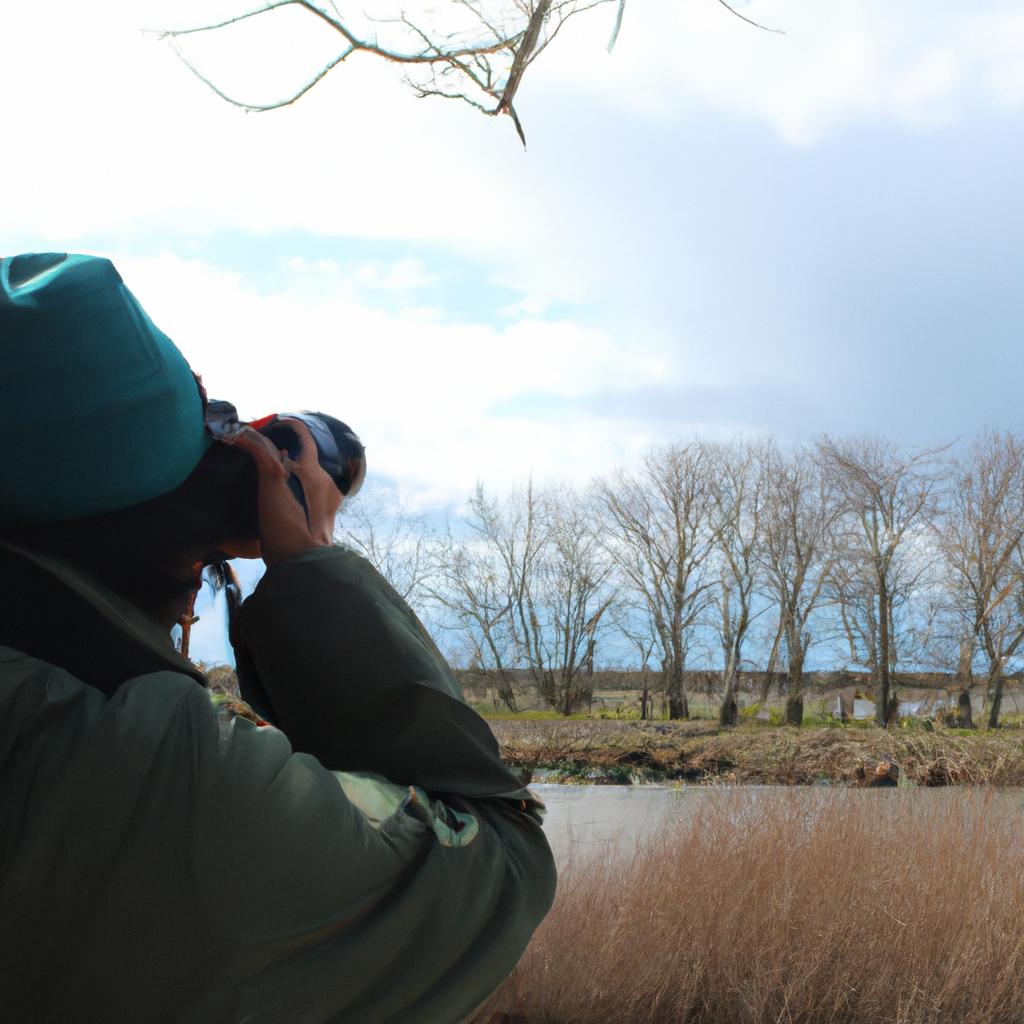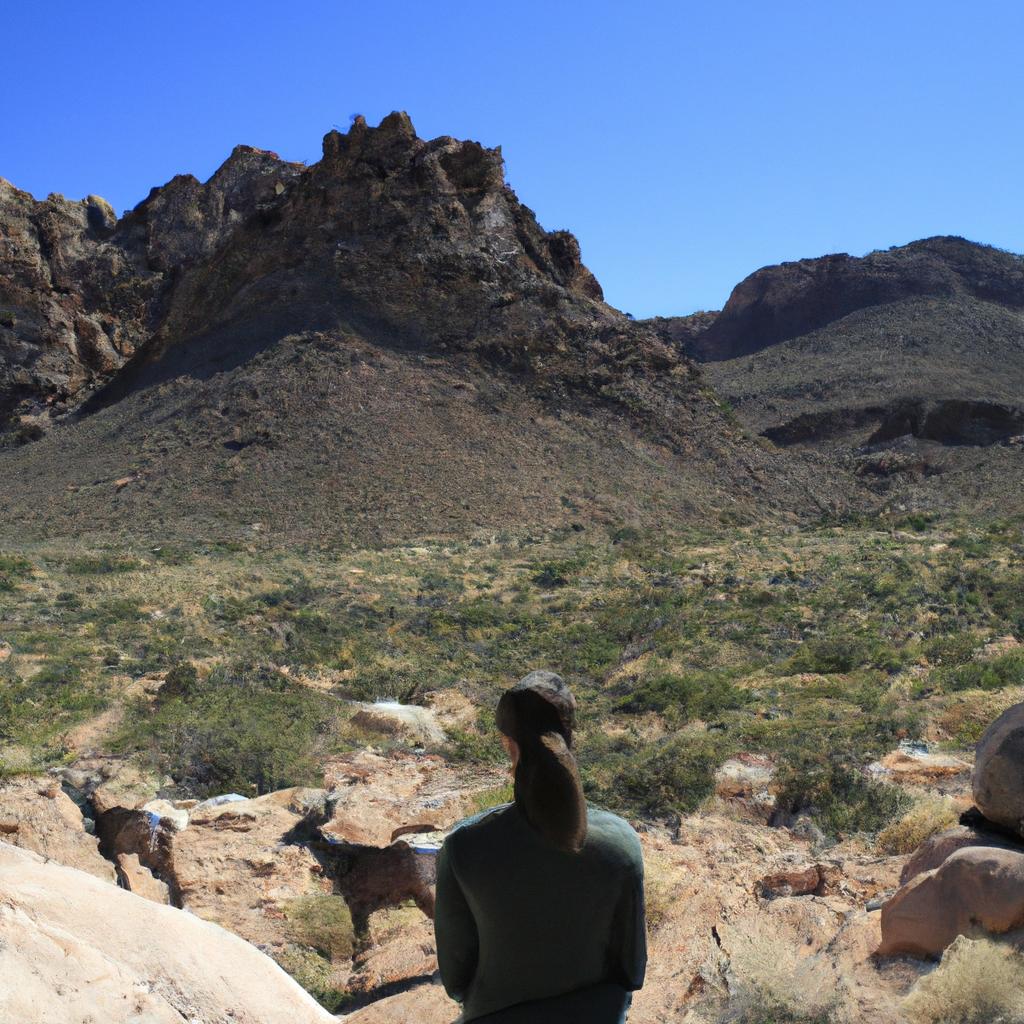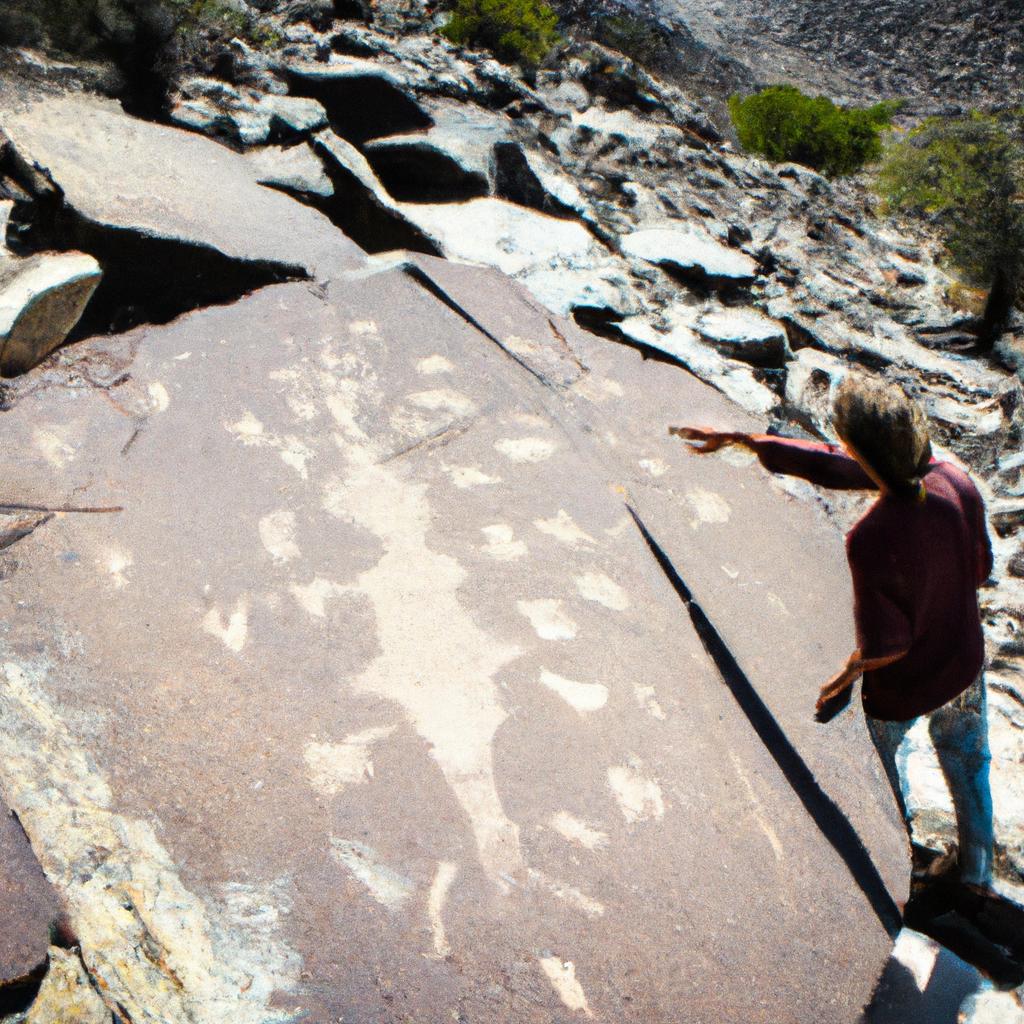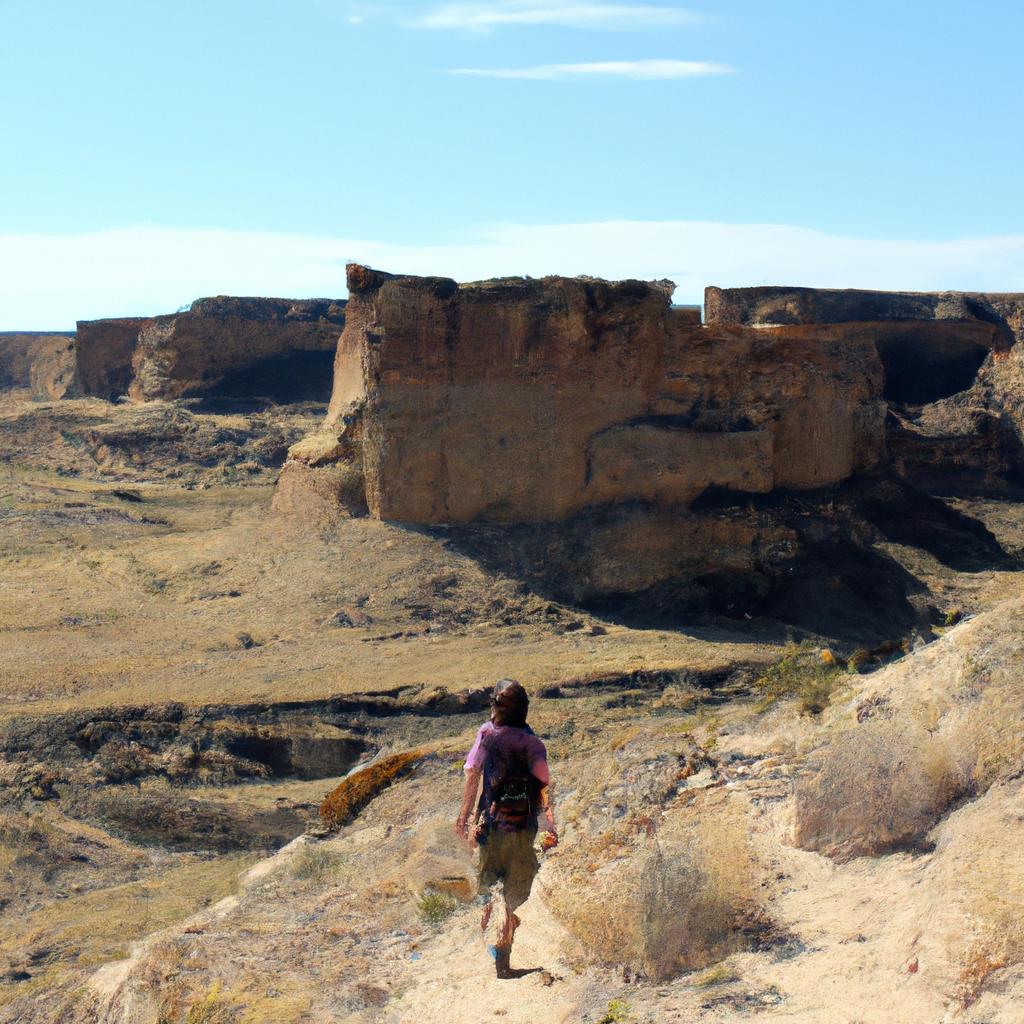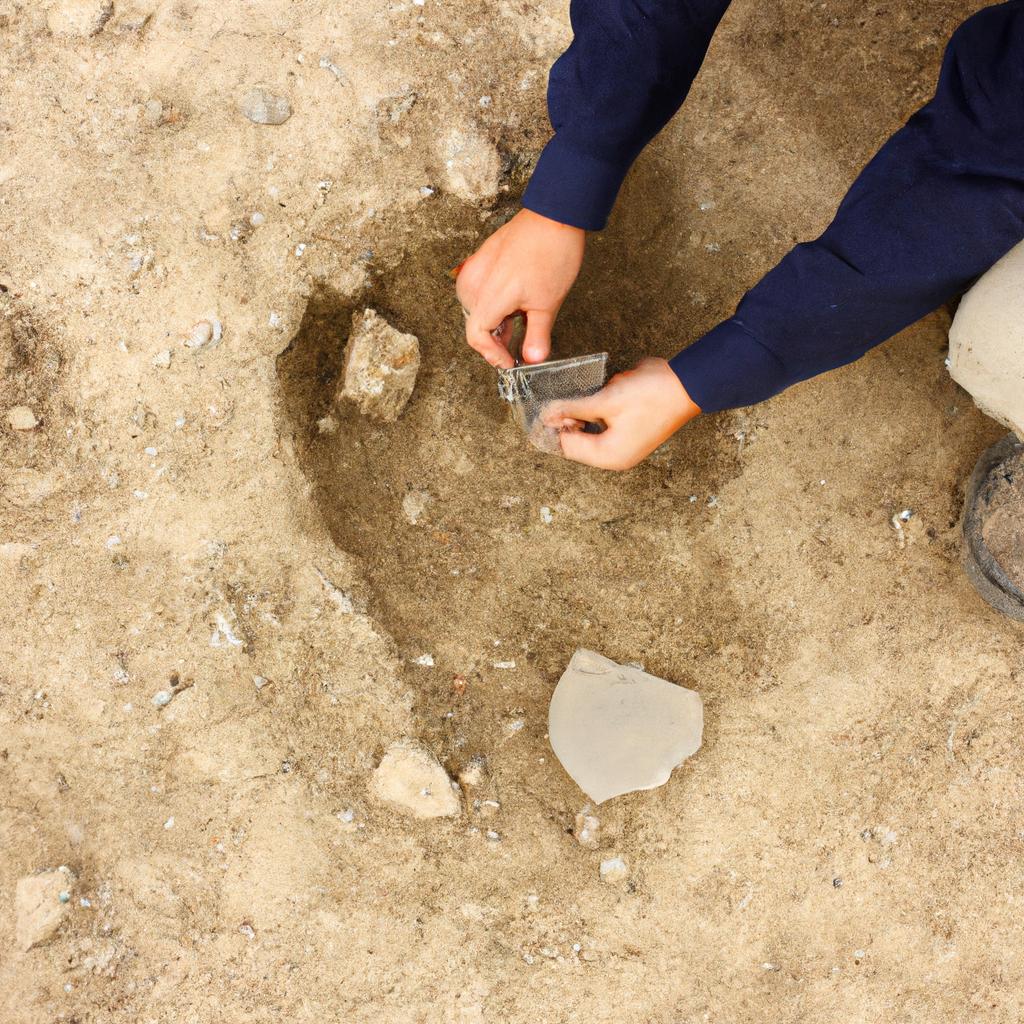Birdwatching is a popular activity for nature enthusiasts and travelers alike, offering a unique opportunity to observe the fascinating behaviors and vibrant plumage of various bird species. One example that showcases the allure of birdwatching can be found in Chaco Canyon—a remote and arid region located in northwestern New Mexico, USA. This article aims to explore the captivating experience of birdwatching during hiking expeditions in Chaco Canyon, shedding light on the diverse avian population thriving amidst its rugged terrain.
Chaco Canyon’s rich biodiversity supports an array of feathered wonders, making it an ideal destination for avid birdwatchers. Despite its harsh desert environment, this secluded canyon provides vital habitat for numerous species, including raptors such as golden eagles and prairie falcons. These majestic birds soar above the expansive landscape with grace and agility, drawing awe from observers who witness their aerial acrobatics. Other notable inhabitants include colorful songbirds like western tanagers and black-headed grosbeaks, adding splashes of vibrancy to the otherwise muted surroundings. The juxtaposition between the desolate beauty of Chaco Canyon and the lively presence of these avian residents creates an enthralling atmosphere for both seasoned birdwatchers seeking rare sightings and newcomers eager to embark on their first birdwatching adventure.
One of the best ways to experience the avian wonders of Chaco Canyon is through hiking expeditions. The canyon’s network of trails provides ample opportunities to explore different habitats and encounter a variety of bird species along the way. As hikers traverse the rugged terrain, they may come across secretive birds like canyon wrens and rock wrens, known for their melodious songs echoing off the canyon walls. Patient observers might even catch a glimpse of the elusive greater roadrunner darting across the desert floor or spot a burrowing owl perched on a rocky outcrop.
In addition to its resident species, Chaco Canyon serves as an important stopover site for migratory birds. During certain seasons, flocks of sandhill cranes and waterfowl make their temporary homes in nearby wetlands, creating spectacular displays of flight and calls that fill the air with excitement. Birdwatchers can witness these captivating movements while exploring Chaco’s riparian areas or by visiting nearby natural reserves such as Bosque del Apache National Wildlife Refuge.
To enhance your birdwatching experience in Chaco Canyon, it is recommended to bring binoculars or a spotting scope for better observation. A field guide specific to birds found in this region can also be helpful in identifying unfamiliar species. It is important to respect the wildlife and their habitats by observing from a distance and refraining from disturbing nesting sites or sensitive areas.
Whether you are an experienced birder or new to this hobby, Chaco Canyon offers an enchanting setting to connect with nature and appreciate the diverse birdlife that thrives against all odds in this arid landscape. So pack your gear, lace up your boots, and prepare for a memorable birdwatching adventure amidst the ancient ruins and sublime beauty of Chaco Canyon.
Chaco Canyon: A Birdwatcher’s Paradise
Imagine standing amidst the stunning landscape of Chaco Canyon, surrounded by ancient ruins and massive sandstone cliffs. As you take in the breathtaking scenery, your attention is drawn to a flash of color overhead—a vibrant Western Tanager perched on a tree branch. Welcome to Chaco Canyon, a place renowned for its abundant birdlife and an enticing destination for avid birdwatchers.
Chaco Canyon offers a diverse range of habitats that attract numerous avian species throughout the year. From open grasslands to riparian areas along the canyon floor, birds find ample food sources and nesting sites in this unique environment. The combination of natural features and archaeological structures creates a captivating backdrop for observing feathered wonders.
Why visit Chaco Canyon?
- Rich biodiversity: With over 150 different bird species recorded in the area, Chaco Canyon boasts an impressive array of avian life.
- Rare sightings: On occasion, lucky visitors may catch sight of elusive species such as the endangered Southwestern Willow Flycatcher or the secretive Gray Vireo.
- Migration stopover: Positioned along major migration routes, Chaco Canyon serves as a vital rest stop for migratory birds traveling between their breeding and wintering grounds.
- Cultural significance: In addition to its ecological importance, Chaco Canyon holds immense cultural value as it was once home to ancestral Puebloan peoples who left behind remarkable architectural marvels.
To provide further insight into the avifauna found within this fascinating location, refer to Table 1 below:
| Species Name | Habitat Preference | Conservation Status |
|---|---|---|
| Mourning Dove | Grasslands | Least Concern |
| Rufous Hummingbird | Riparian Areas | Least Concern |
| Western Bluebird | Pinyon-Juniper Woodlands | Least Concern |
| Gambel’s Quail | Sagebrush Scrub | Least Concern |
(Table 1: A selection of bird species found in Chaco Canyon, their preferred habitats, and conservation status.)
Spotting these feathered inhabitants is an enthralling experience that offers both natural beauty and cultural significance.
Spotting Rare Avian Species in Chaco Canyon
With a wealth of diverse ecosystems and extensive knowledge on local bird populations, uncovering the secrets of rare avian species becomes an exhilarating endeavor during your visit to Chaco Canyon.
Spotting Rare Avian Species in Chaco Canyon
H2: Chaco Canyon: A Birdwatcher’s Paradise
As we delve deeper into the enchanting world of birdwatching in Chaco Canyon, it becomes evident that this ancient landscape is a haven for avian enthusiasts. The sheer diversity and abundance of bird species make every hike an exciting adventure. Let us explore some fascinating aspects of spotting feathered wonders during your travels to Chaco Canyon.
Imagine yourself standing amidst the rich tapestry of nature, gazing up at the clear blue sky overhead. Suddenly, a flash of vibrant colors catches your attention – a magnificent Western Tanager perched on a nearby branch. This striking songbird with its bright yellow body and scarlet head stands out against the backdrop of desert hues. The sight leaves you captivated, igniting a sense of wonder about the hidden treasures yet to be discovered in this remarkable place.
To fully appreciate the allure of birdwatching in Chaco Canyon, consider these key factors:
-
Ecological Niche: Chaco Canyon boasts a unique combination of habitats ranging from arid shrublands to riparian zones along streams. Each habitat supports distinct bird communities, creating opportunities to observe various species within close proximity.
-
Seasonal Migration: As birds travel across vast distances during their seasonal migrations, they often pass through or find respite in Chaco Canyon. Witnessing flocks of migratory birds stopping by adds an element of excitement and unpredictability to your birdwatching experience.
-
Rare Avian Species: Alongside common regional inhabitants such as Black-throated Sparrows and Sagebrush Sparrows, occasional rare visitors grace Chaco Canyon with their presence. These elusive species offer avid birders thrilling encounters and potentially even new additions to their life lists.
- Ecological Niche: Enjoy diverse habitats supporting different bird communities.
- Seasonal Migration: Marvel at migrating birds passing through or resting here.
- Rare Avian Species: Encounter elusive and uncommon bird species.
- Unpredictable Discoveries: Experience the excitement of unexpected sightings.
Markdown formatted table:
| Ecological Niche | Seasonal Migration | Rare Avian Species | |
|---|---|---|---|
| 1. | Diverse habitats provide a home to various bird communities. | Birds passing through or stopping by during migration seasons. | Occasional rarities grace Chaco Canyon, offering unique encounters. |
| 2. | Opportunity to observe different avian species in close proximity. | Witness flocks of migratory birds adding dynamic energy to your experience. | Thrilling chance for new additions to birders’ life lists. |
| 3. | Explore distinct ecosystems within Chaco Canyon’s boundaries. | Experience the ebb and flow of bird populations throughout the year. | Discover hidden gems among the vibrant tapestry of Chaco’s avifauna. |
In this remarkable landscape teeming with feathered wonders, each hike holds endless possibilities for discovery. As you venture further into our exploration of Chaco Canyon’s avian treasures, let us now delve into the best time of year for optimal birdwatching experiences in this awe-inspiring setting.
[Transition sentence into subsequent section about “Best Time of Year for Birdwatching in Chaco Canyon.”]
Best Time of Year for Birdwatching in Chaco Canyon
Spotting Rare Avian Species in Chaco Canyon:
Chaco Canyon, with its unique desert ecosystem and diverse habitats, offers a remarkable opportunity for birdwatchers to observe rare avian species. The area’s rich biodiversity attracts both migratory birds and resident species, making it an ideal destination for avid ornithologists. For instance, let’s consider the case of the elusive Black-throated Sparrow (Amphispiza bilineata), which is known to inhabit the rocky slopes and arid grasslands of Chaco Canyon.
One can increase their chances of spotting these fascinating creatures by following certain guidelines:
- Stay patient and observant: Birds often camouflage themselves amidst the canyon’s natural surroundings. Observing their behavior from a distance allows them to feel less threatened and increases your chances of witnessing their natural activities.
- Choose strategic locations: Focusing on areas near water sources such as seeps or springs will attract a variety of bird species searching for hydration. Additionally, exploring different altitudes within the canyon provides opportunities to encounter distinct avian communities.
- Use binoculars or a telephoto lens: These tools enable you to observe birds without disturbing their habitat while providing detailed views that might not be visible to the naked eye.
- Learn common calls and songs: Familiarizing yourself with local bird vocalizations aids in identifying specific species even before sighting them visually.
To further enhance your understanding of Chaco Canyon’s avifauna, here is an example table showcasing some notable bird species found in this region along with their distinctive characteristics:
| Species | Distinctive Characteristics |
|---|---|
| Western Bluebird | Vibrant blue plumage; melodious song |
| Rufous-sided Towhee | Rust-colored sides; scratchy call |
| Gambel’s Quail | Plumed topknot; distinct “ka-KOW-ka” call |
| Black-chinned Hummingbird | Iridescent purple throat; rapid wingbeats |
Observing these magnificent birds in their natural habitat can evoke a sense of awe and appreciation for the diverse wildlife found within Chaco Canyon. The next section will delve into the essential gear needed to fully enjoy your birdwatching experience, including binoculars and other equipment.
[Transition] Equipped with knowledge about spotting rare avian species and understanding their characteristics, let’s now explore the tools necessary for an immersive birdwatching adventure in Chaco Canyon.
Binoculars and Other Essential Gear for Birdwatching
Birdwatching enthusiasts visiting Chaco Canyon have the opportunity to witness a diverse array of feathered wonders during their hiking expeditions. As they embark on their explorations, it is important to consider various factors that can enhance the birdwatching experience and maximize the chances of encountering these captivating creatures.
One example that highlights the significance of timing in birdwatching is the observation of migratory birds at Chaco Canyon. During spring and fall, numerous species pass through this region as they journey between breeding grounds and wintering sites. By planning visits during these seasons, birdwatchers increase their likelihood of witnessing an influx of different avian species within the canyon’s vicinity.
To make the most out of their excursion, avid birdwatchers should equip themselves with essential gear such as binoculars. These optical instruments enable observers to spot birds from a distance without disturbing them or altering their natural behavior. Additionally, carrying field guides or utilizing smartphone applications can assist in identifying unfamiliar species encountered along the trails.
Engaging with nature immerses individuals in moments filled with awe and appreciation for our planet’s biodiversity. To evoke an emotional response among readers, here are four reasons why birdwatching in Chaco Canyon can be a truly enriching experience:
- The tranquility experienced while observing birds amidst picturesque landscapes fosters a sense of inner peace.
- Witnessing rare and elusive species instills a sense of wonder and excitement, leaving lasting memories.
- Birdwatching cultivates a deeper understanding and connection to nature, fostering environmental stewardship.
- Sharing sightings and experiences with other passionate birdwatchers creates a sense of community and camaraderie.
Furthermore, exploring bird habitats within Chaco Canyon reveals fascinating insights into its ecological diversity. The following table showcases three distinct ecosystems found within the area:
| Ecosystem | Key Features | Notable Avian Species |
|---|---|---|
| Riparian | Lush vegetation along waterways, providing a haven for birds reliant on these habitats | Yellow-breasted Chat (Icteria virens), Common Black-Hawk (Buteogallus anthracinus) |
| Pinyon-Juniper | Woodland characterized by pinyon pine and juniper trees, attracting species adapted to this environment | Juniper Titmouse (Baeolophus ridgwayi), Bushtit (Psaltriparus minimus) |
| Sagebrush Desert | Vast expanse of arid shrublands dominated by sagebrush plants | Sage Thrasher (Oreoscoptes montanus), Brewer’s Sparrow (Spizella breweri), Greater Roadrunner (Geococcyx californianus) |
By exploring the diverse bird habitats in Chaco Canyon, enthusiasts can deepen their understanding of avian adaptations to specific environments. This knowledge serves as a foundation for appreciating the delicate balance between wildlife and its surroundings.
Transitioning into the subsequent section about “Exploring the Diverse Bird Habitats of Chaco Canyon,” readers are encouraged to delve further into the wonders awaiting them amidst Chaco Canyon’s enchanting landscapes.
Exploring the Diverse Bird Habitats of Chaco Canyon
Now, let’s delve into the fascinating world of bird habitats within Chaco Canyon. To truly appreciate the diverse avian species that reside in this region, it is important to understand the unique environments they inhabit. One prime example is the riparian habitat found along the canyon floor. This area offers a lush oasis amidst the arid desert surroundings, attracting numerous bird species seeking water and shelter.
To fully immerse yourself in these captivating bird habitats, here are some key features you can observe:
- Dense Vegetation: The riparian environment boasts an abundance of tall trees, shrubs, and grasses providing ample cover for birds to nest and rest.
- Water Sources: From natural springs to small streams, water sources within this habitat sustain both resident and migratory bird populations throughout the year.
- Insect Activity: The flourishing vegetation attracts insects, which serve as a vital food source for many bird species residing in this habitat.
- Avian Diversity: Due to its favorable conditions, riparian areas often support a wide range of bird species with varying ecological niches.
To further illustrate the richness of Chaco Canyon’s avifauna, consider the following table showcasing notable bird species commonly observed within different habitats:
| Habitat | Notable Birds |
|---|---|
| Riparian | Yellow Warbler |
| Black-headed Grosbeak | |
| Grasslands | Western Meadowlark |
| Lark Bunting | |
| Desert Scrub | Cactus Wren |
| Greater Roadrunner | |
| Woodland | Plumbeous Vireo |
| Pygmy Nuthatch |
As we explore these diverse ecosystems during our journey through Chaco Canyon, we gain not only a deeper understanding of nature but also an appreciation for its intricate balance. The interplay between vegetation, water sources, and the avian species that rely on them creates a harmonious tapestry of life.
In our next section, we will focus on tips for identifying and recording bird species in Chaco Canyon. By honing our skills in observing and documenting these feathered wonders, we can contribute to ongoing research efforts while enhancing our personal connection with nature’s extraordinary creations.
Tips for Identifying and Recording Bird Species in Chaco Canyon
As we continue our journey through the captivating landscapes of Chaco Canyon, it is impossible to overlook the diverse bird habitats that thrive within this ancient region. From soaring raptors to tiny songbirds, these feathered wonders add a vibrant and melodic touch to the already awe-inspiring scenery. One such example is the peregrine falcon (Falco peregrinus), known for its remarkable speed and aerial hunting prowess. The presence of these majestic birds serves as a testament to the rich biodiversity found in Chaco Canyon.
To fully appreciate the variety of avian life present in Chaco Canyon, it is crucial to understand their preferred habitats. Here are some key insights into the different environments where you can encounter various species:
- Riparian Zones: These areas along rivers and streams offer lush vegetation and ample food sources, attracting water-loving birds like herons, ducks, and kingfishers.
- Grasslands: Vast expanses of grass provide nesting grounds for ground-dwelling birds such as meadowlarks and lark buntings.
- Woodlands: Forested areas teem with activity as woodpeckers tap on tree trunks while warblers flit through branches searching for insects.
- Cliffs and Canyons: Precipitous cliffs create ideal nesting sites for cliff swallows, which build intricate mud nests attached to vertical surfaces.
In order to better visualize the diversity of bird species inhabiting Chaco Canyon’s distinct habitats, consider the following table:
| Habitat | Key Species |
|---|---|
| Riparian Zones | Great Blue Heron |
| Belted Kingfisher | |
| Mallard Duck | |
| Grasslands | Western Meadowlark |
| Lark Bunting | |
| Woodlands | Northern Flicker |
| Black-throated Gray Warbler | |
| Cliffs and Canyons | Cliff Swallow |
This table serves as a testament to the wide range of bird species that call Chaco Canyon home. Each habitat provides its own unique niche, supporting different birds with their specific preferences and requirements.
In the midst of this avian diversity, it becomes clear that Chaco Canyon holds an extraordinary appeal for bird enthusiasts and nature lovers alike. The harmonious symphony of melodic calls echoing through the canyon walls combined with the vibrant plumage on display truly evokes a sense of wonder and admiration. As we venture further into this fascinating landscape, let us continue our exploration with open eyes and ears, ready to encounter even more feathered treasures along the way.

